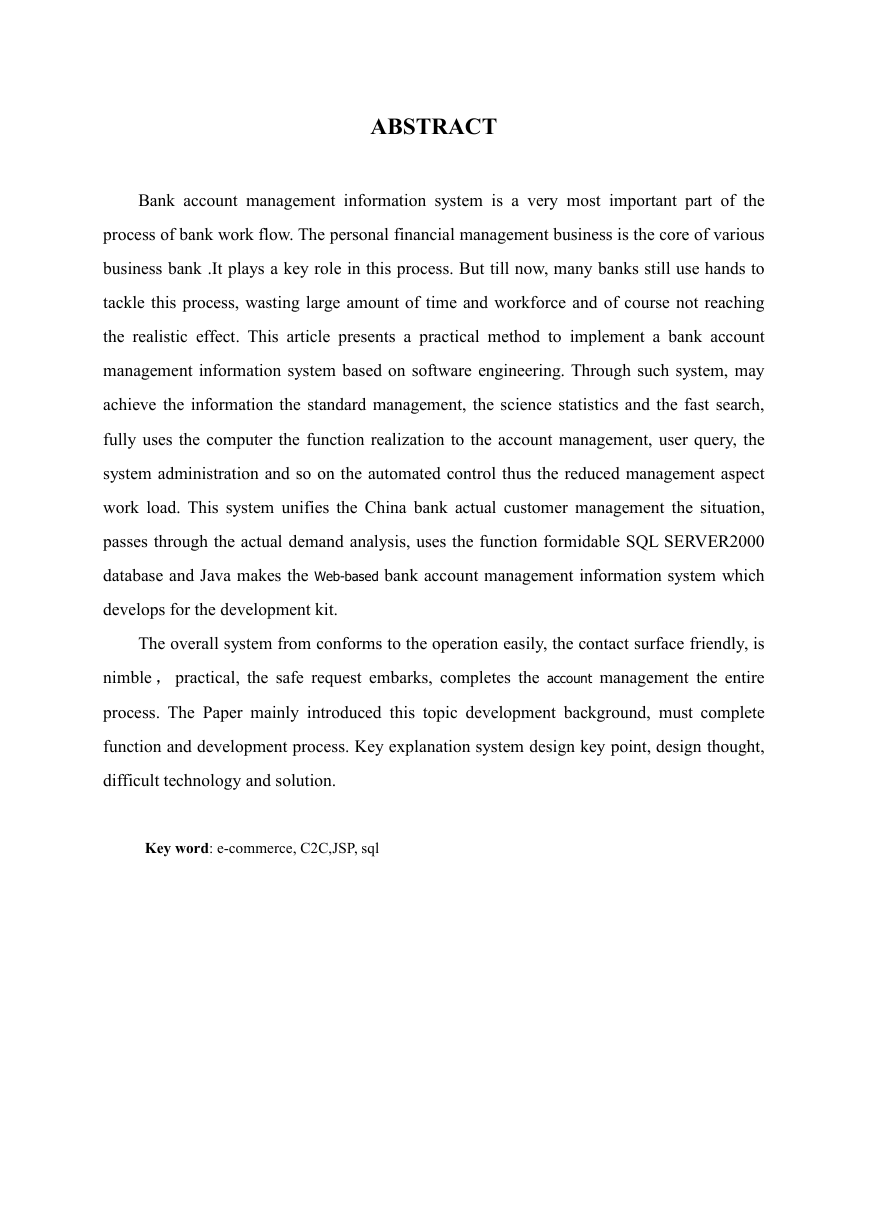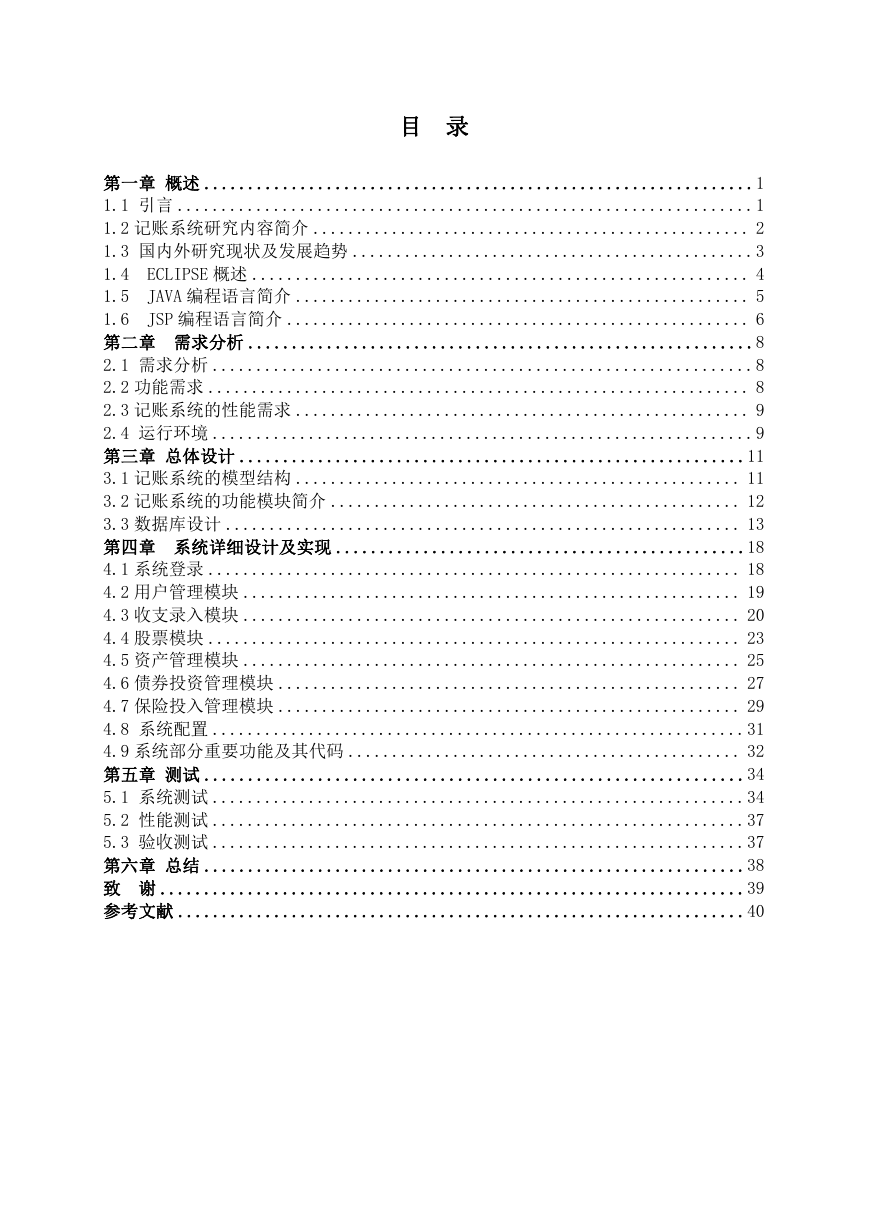摘 要
银行记账系统是银行业务流程过程中十分重要且必备的环节之一,其中个人理财业
务又是银行各个业务的核心。但是,目前许多银行在个人理财业务流程处理过程中仍然
使用手工操作的方式来实施,不仅费时、费力,效率低下,而且无法达到理想的效果。
本文针对上述问题,采用软件工程的开发原理,依据软件流程过程规范,按照需求分析、
概要设计、详细设计、程序编码、测试、软件应用、软件维护等过程开发了一个银行记
账系统。通过这个系统,可以做到信息的规范管理、科学统计和快速的查找,充分利用
计算机的功能实现对客户业务、管理业务、统计业务、系统管理等的自动化控制从而减
少管理方面的工作量。本系统经过实际的需求分析,采用功能强大的 SQL SERVER2000
数据库和 Java 技术作为开发工具而开发出来的基于 Web 的银行记账系统。
整个系统从符合操作简便、界面友好、灵活、实用、安全的要求出发,完成记账系
统的全过程。论文主要介绍了本课题的开发背景,所要完成的功能和开发的过程。重点
的说明了系统设计的重点、设计思想、难点技术和解决方案。
关键字:电子商务,C2C,JSP,sql
�
ABSTRACT
Bank account management information system is a very most important part of the
process of bank work flow. The personal financial management business is the core of various
business bank .It plays a key role in this process. But till now, many banks still use hands to
tackle this process, wasting large amount of time and workforce and of course not reaching
the realistic effect. This article presents a practical method to implement a bank account
management information system based on software engineering. Through such system, may
achieve the information the standard management, the science statistics and the fast search,
fully uses the computer the function realization to the account management, user query, the
system administration and so on the automated control thus the reduced management aspect
work load. This system unifies the China bank actual customer management the situation,
passes through the actual demand analysis, uses the function formidable SQL SERVER2000
database and Java makes the Web-based bank account management information system which
develops for the development kit.
The overall system from conforms to the operation easily, the contact surface friendly, is
nimble , practical, the safe request embarks, completes the account management the entire
process. The Paper mainly introduced this topic development background, must complete
function and development process. Key explanation system design key point, design thought,
difficult technology and solution.
Key word: e-commerce, C2C,JSP, sql
�
目 录
第一章 概述 ...............................................................1
1.1 引言 ..................................................................1
1.2 记账系统研究内容简介 .................................................. 2
1.3 国内外研究现状及发展趋势 ..............................................3
ECLIPSE 概述 ......................................................... 4
1.4
JAVA 编程语言简介 .................................................... 5
1.5
1.6
JSP 编程语言简介 ..................................................... 6
第二章 需求分析 ..........................................................8
2.1 需求分析 ..............................................................8
2.2 功能需求 .............................................................. 8
2.3 记账系统的性能需求 .................................................... 9
2.4 运行环境 ..............................................................9
第三章 总体设计 ..........................................................11
3.1 记账系统的模型结构 ................................................... 11
3.2 记账系统的功能模块简介 ............................................... 12
3.3 数据库设计 ........................................................... 13
第四章 系统详细设计及实现 ...............................................18
4.1 系统登录 ............................................................. 18
4.2 用户管理模块 ......................................................... 19
4.3 收支录入模块 ......................................................... 20
4.4 股票模块 ............................................................. 23
4.5 资产管理模块 ......................................................... 25
4.6 债券投资管理模块 ..................................................... 27
4.7 保险投入管理模块 ..................................................... 29
4.8 系统配置 .............................................................31
4.9 系统部分重要功能及其代码 ............................................. 32
第五章 测试 ..............................................................34
5.1 系统测试 .............................................................34
5.2 性能测试 .............................................................37
5.3 验收测试 .............................................................37
第六章 总结 ..............................................................38
致 谢 ...................................................................39
参考文献 .................................................................40
�






 2023年江西萍乡中考道德与法治真题及答案.doc
2023年江西萍乡中考道德与法治真题及答案.doc 2012年重庆南川中考生物真题及答案.doc
2012年重庆南川中考生物真题及答案.doc 2013年江西师范大学地理学综合及文艺理论基础考研真题.doc
2013年江西师范大学地理学综合及文艺理论基础考研真题.doc 2020年四川甘孜小升初语文真题及答案I卷.doc
2020年四川甘孜小升初语文真题及答案I卷.doc 2020年注册岩土工程师专业基础考试真题及答案.doc
2020年注册岩土工程师专业基础考试真题及答案.doc 2023-2024学年福建省厦门市九年级上学期数学月考试题及答案.doc
2023-2024学年福建省厦门市九年级上学期数学月考试题及答案.doc 2021-2022学年辽宁省沈阳市大东区九年级上学期语文期末试题及答案.doc
2021-2022学年辽宁省沈阳市大东区九年级上学期语文期末试题及答案.doc 2022-2023学年北京东城区初三第一学期物理期末试卷及答案.doc
2022-2023学年北京东城区初三第一学期物理期末试卷及答案.doc 2018上半年江西教师资格初中地理学科知识与教学能力真题及答案.doc
2018上半年江西教师资格初中地理学科知识与教学能力真题及答案.doc 2012年河北国家公务员申论考试真题及答案-省级.doc
2012年河北国家公务员申论考试真题及答案-省级.doc 2020-2021学年江苏省扬州市江都区邵樊片九年级上学期数学第一次质量检测试题及答案.doc
2020-2021学年江苏省扬州市江都区邵樊片九年级上学期数学第一次质量检测试题及答案.doc 2022下半年黑龙江教师资格证中学综合素质真题及答案.doc
2022下半年黑龙江教师资格证中学综合素质真题及答案.doc